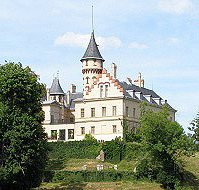
The Raduň laundry is awaiting repairs, the fate of the former sheepfold is unclear
 |
| Raduň Castle |
While the laundry is set to undergo reconstruction and new utilization after years of neglect, questions still hang over the fate of the neoclassical sheepfold. Its owners have made the necessary repairs to prevent further deterioration. They are now looking for new uses for the expansive one-story building located right next to the castle.
The residents of Raduň refer to the former laundry only as Vošárna. The local name comes from the German word wasch, which means washing in Czech. The building, with its unique mansard roof, is intended to serve as a community and cultural center for the village in the future. "For fifteen years I watched the house decay. Nobody cared about it," said ČTK Rostislav Müller, who bought the laundry at auction and later transferred it to the civic association Vošárna, which seeks to restore it.
"From the emergency fund, we obtained a grant for roof repairs. That has already been completed. We also have funds for the overall reconstruction," Müller stated. According to him, a concert hall is to be created on the upper floor and club rooms on the lower floor, which should primarily be used by local organizations.
However, the fate of the former sheepfold from 1841, which lies within sight of the Raduň castle, is much less certain. "The building is significantly marked and damaged. The interior space is completely devastated. Only remnants of the late neoclassical facade remain on the outside," said ČTK castle curator Eva Kolářová. She added that the building is in a state of emergency. "A major problem is also the damp masonry and crumbling bricks," she said, adding that at the height of its glory, the interior of the building was adorned with marble gutters.
The sheepfold also now belongs to a group of private owners. Unlike Vošárna, the entrepreneurs intend to utilize the property commercially. There has been talk of housing for seniors, for example. "We still do not have a specific idea. There are several concepts. For now, we have not decided on anything concrete. Until that happens, we do not want to present our plans publicly," one of the owners, Jan Illík, told ČTK. However, he believes that the building should serve people. He rejects the idea of using it as a manufacturing or storage hall.
Illík added that the owners have so far succeeded in stopping the deterioration of the monument. "In several places, the roof had collapsed, allowing rainwater into the building. Our effort was to repair the most significant damage. To fix the trusses, the cornice, the roofing, and the masonry. This is the state of the sheepfold today. It has a temporary roof, and we are waiting to see what happens next," explained Illík, co-owner.
Both buildings have become part of the Endangered Heritage project organized by the National Heritage Institute. The purpose of the initiative is to present historical buildings marked by the ravages of time to the public during guided tours. At the end of each tour, discussions about the future of the buildings are planned.
Both the laundry and the sheepfold were part of the Raduň castle complex. The laundry and drying room, with its distinctive high mansard roof, was built on the edge of the castle complex in practical proximity to the Raduňka river sometime between 1793 and 1823. Laundry was washed here until the war; after the war, the building was used for private living. Since 1986, according to the staff of the heritage institute, it has belonged to several owners whose plans went unfulfilled, leading the property to the brink of emergency demolition.
The sheepfold is in a similar condition today. In 1947, it was transferred to the state, and its owners changed gradually. The use of the building also changed. It most often housed cows or breeding bulls.
The English translation is powered by AI tool. Switch to Czech to view the original text source.
0 comments
add comment












